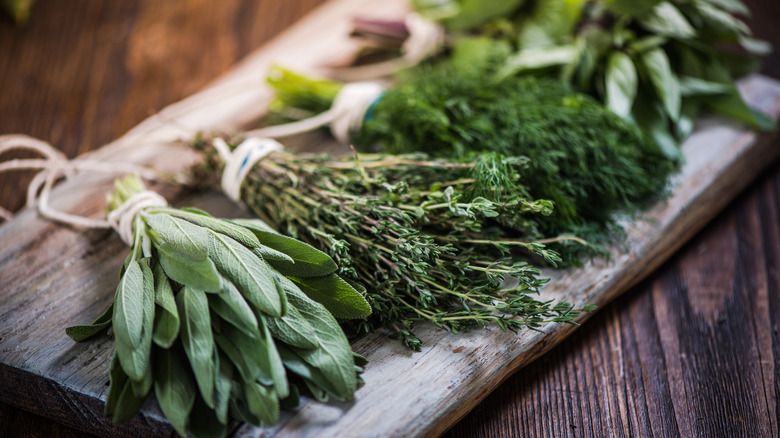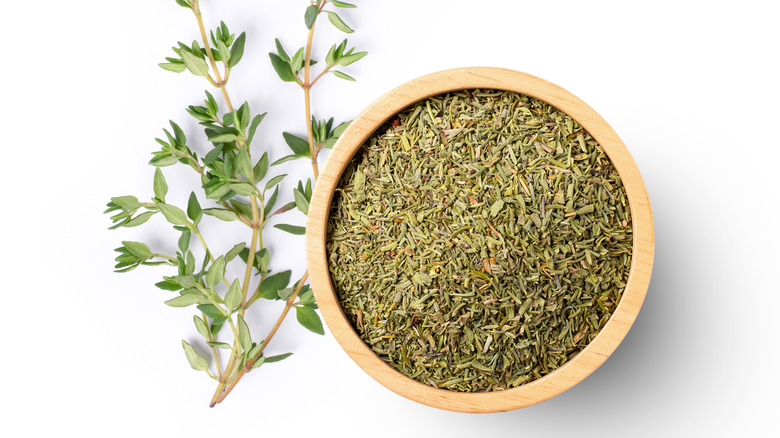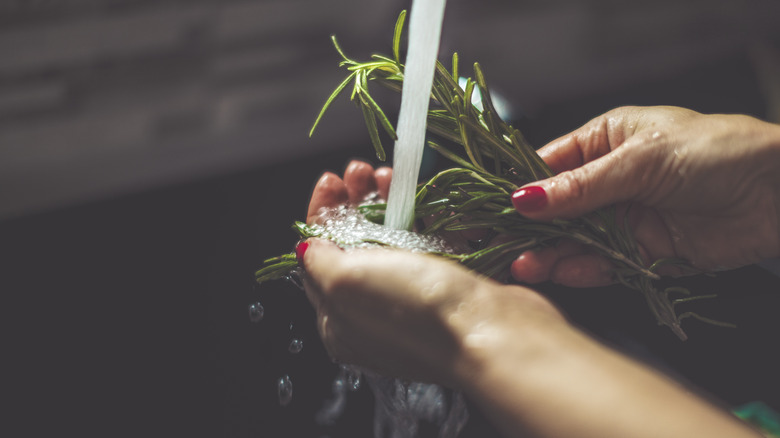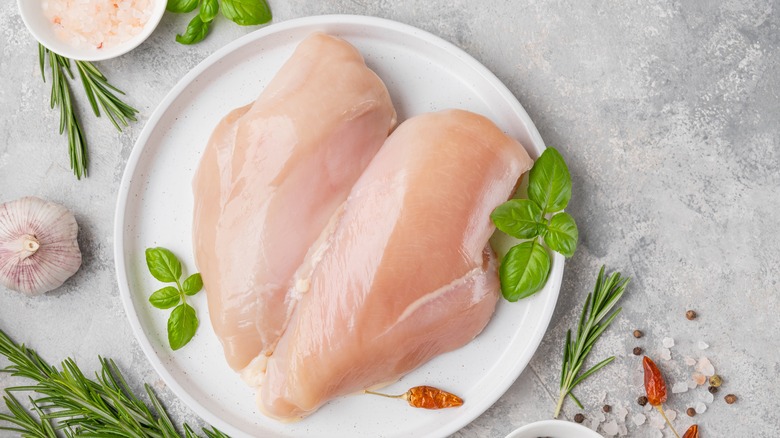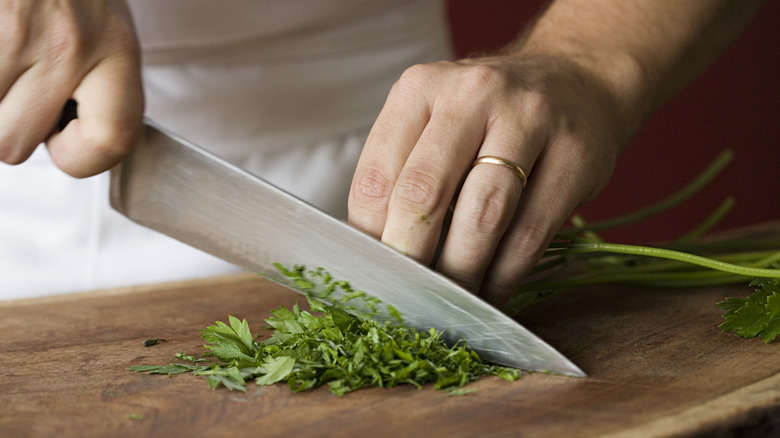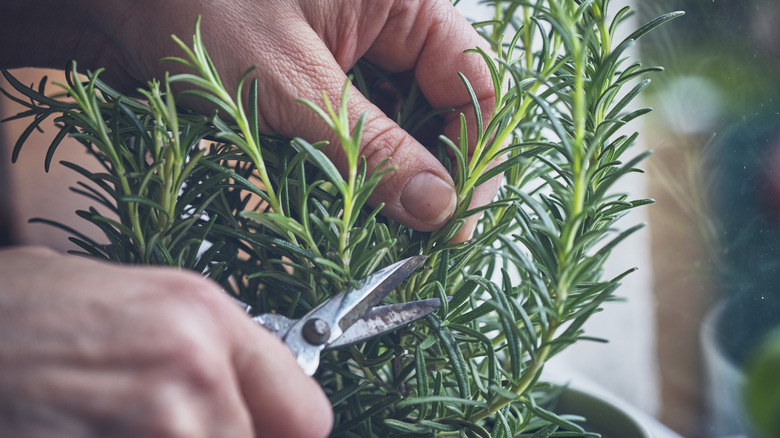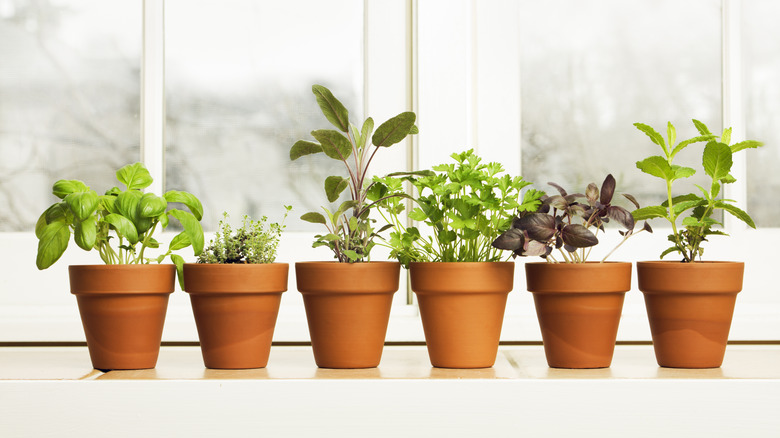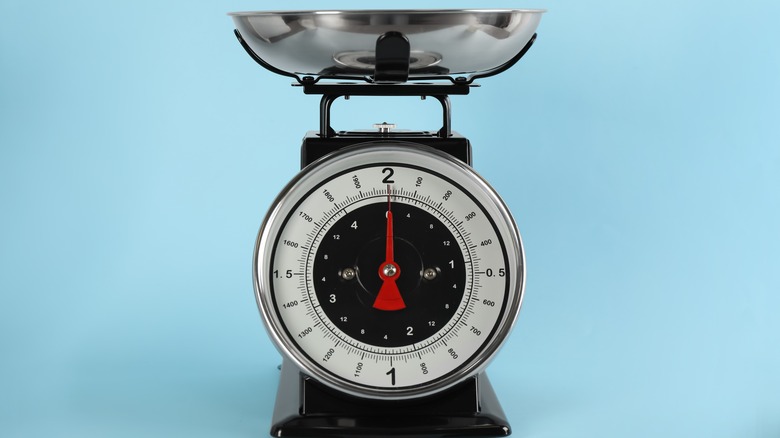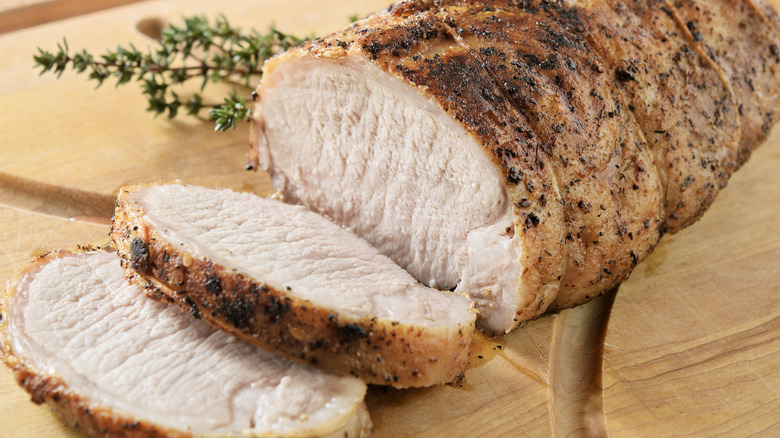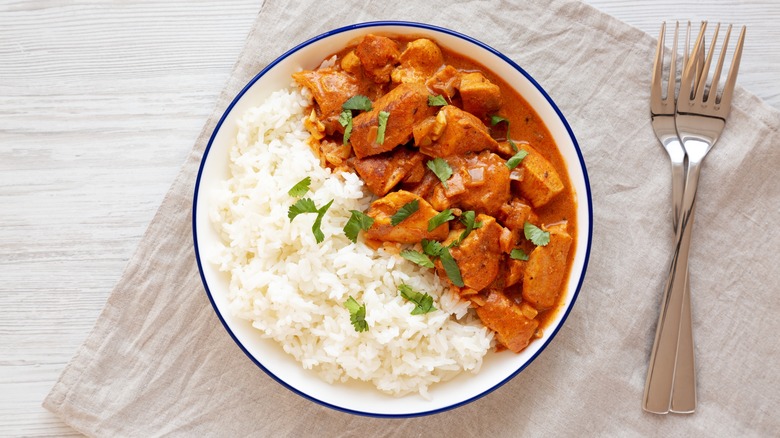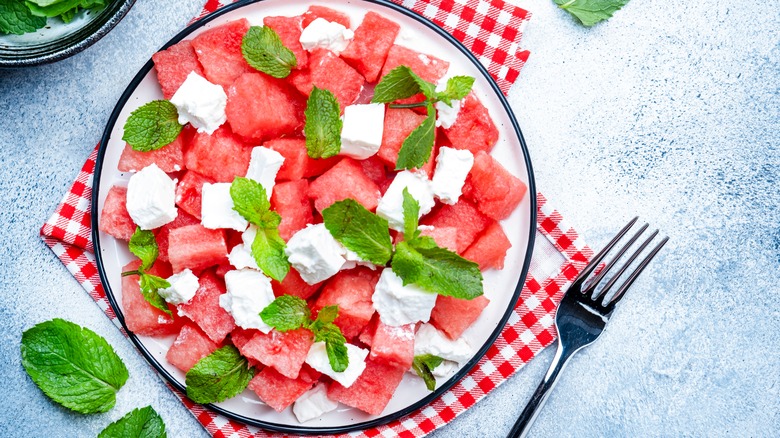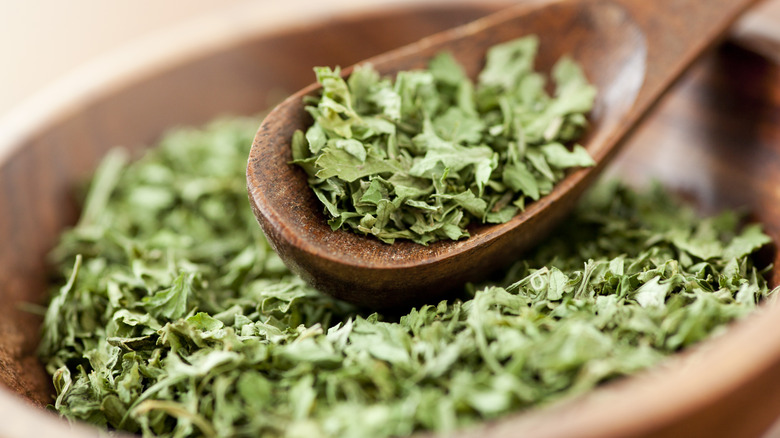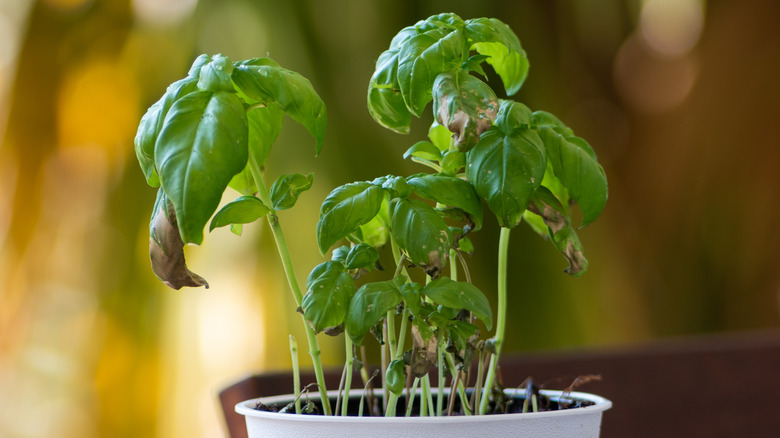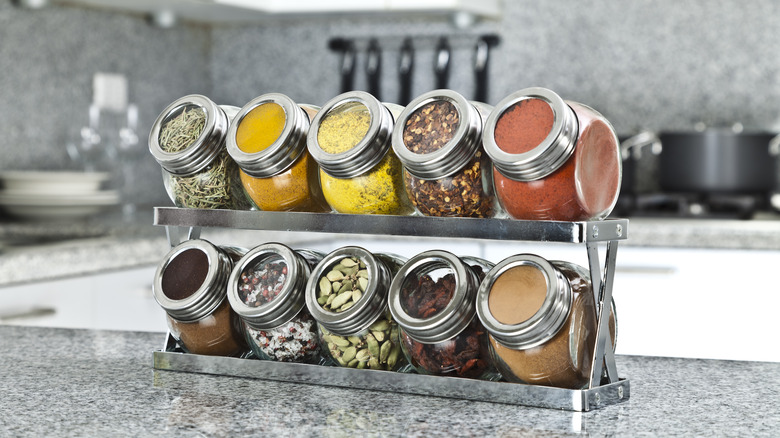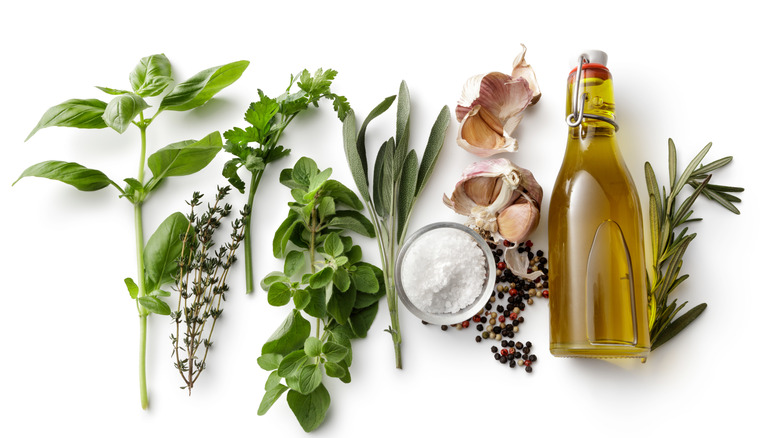15 Mistakes Everyone Makes When Cooking With Herbs
Herbs are delicious and can really bring out the best in a recipe when properly added — but this can be surprisingly difficult to do. It's incredibly easy to add too many herbs to a dish, and it's even easier to add herbs at the wrong time and end up with burnt leaves on your baked rosemary chicken. And then there's the question of whether you can replace fresh herbs with dry ones. The answer? Sometimes, but only if you use a completely different amount.
So, yeah — if the thought of cooking with herbs stresses you out, that's totally normal. We've all been there (and created an overly basil-laden pizza sauce or two). But with a little knowledge, practice, and care, you can become a confident herb user. The best way to begin this journey? Reading this list. These are the most common mistakes people make when cooking with herbs.
1. Mistake: Not realizing there's a difference between dried and fresh herbs
There are two main types of herbs used in recipes: fresh and dry. Fresh herbs are cut from plants and used pretty much as-is. You can buy them at the store or you can grow them yourself. These have more of the oils that make herbs great, and tend to have a lighter, fresher flavor.
Dried herbs are the dehydrated version of fresh herbs. They don't have as much oil in them, but they often have a deeper, more intense flavor than their fresh counterparts. One exception to this rule is parsley, which loses much of its flavor when it's dried.
While it's possible to replace fresh herbs with dry ones without issue in some recipes, you have to keep in mind that the proportions are different. In general, you should use around a third of the amount of dried herbs as you would fresh. Otherwise, the taste will be too strong and ruin the dish.
2. Mistake: Not washing fresh herbs
You wouldn't eat a salad without washing the vegetables first, right? So it goes with herbs. Herb plants can trap a lot of dirt and sand in their leaves. Curly parsley is notoriously bad about this, making it essential to give it a really good rinse before you use it. This also keeps your knives from getting ruined when you hit a piece of grit.
There may also be something you can't see lurking in your herbs: bacteria. If an herb is cooked at high heat for enough time, this will most likely kill any bacteria present, but there are many herbs that don't get cooked that way. Cilantro, for instance, is usually eaten raw and often sold with dirty roots and sand all over it. A study from 2014 found that many samples of cilantro plants taken from 13 different farmer's markets (along with basil and parsley, which are also often eaten raw) tested positive for E. coli. Salmonella was also found on some of the parsley.
To keep your herbs healthy, wash them in a sink or bowl of cool water and swish them around to remove the dirt or germs that may be on them. Then spin them in a salad spinner, and make sure to let them dry completely before chopping them up.
3. Mistake: Adding herbs at the wrong time
It's not just the amount and type of herbs you have to think about when cooking — you also need to care about timing. Some herbs, if added too early in the cooking process, will burn, making your dish both look and taste bad. Fresh herbs can also lose their flavor if they're cooked too long. But you still need to give the herbs enough time to add their flavor to the dish, so when, exactly, is the best time to add them?
In general, dried herbs are best added during the cooking process. This is because they're dehydrated and can stand up to longer cooking times than fresh herbs. In fact, the cooking process actually helps bring out the flavor that recedes deeper into the herb when it's dried. Fresh herbs are best added at or near the end of cooking time, or used in dishes that aren't cooked for very long. Some herbs like cilantro, parsley, and basil are often sprinkled on after cooking is finished. Always follow your recipe and know your herbs well so that you add them at the precise right time.
4. Mistake: Chopping them too early
Everyone likes saving time in the kitchen, so cutting your herbs ahead of time and leaving them in the refrigerator seems like a great idea. But it's not. Fresh herbs are at their best immediately after being cut. They quickly start to brown and lose flavor after that point, which means that if you leave them too long, you'll have to cut more anyway.
But there may be situations in which you're forced to chop your herbs early — if you're having Thanksgiving dinner at your house, for instance, and need to save time between prepping your turkey and 10 different hors d'oeuvres. In this case, take your sharpest knife and cut your herbs, then place them into a clean dish towel. Twist the towel closed and run water on it from the faucet until it runs clear instead of green. Then remove the herbs from the towel, blot them dry, and put them in the fridge until you need them — ideally within a day or so.
5. Mistake: Thinking every herb should be chopped the same way
When you think about cutting herbs, you probably picture a chef chopping them into tiny pieces with a big, sharp knife. While this is standard for some herbs, others need to be prepped differently. Parsley, cilantro, and dill can all be chopped with a knife in their entirety, including the thin part of the stems (the thick part at the bottom can go, though). But rosemary, thyme, oregano, and tarragon should be removed from their stems entirely.
Herbs with bigger leaves like sage, mint, and basil don't need a knife either. All you have to do is pluck them from their stems (which are woodier and not good to eat) and tear them into pieces with your fingers. If you absolutely have to use your knife, you can cut them into long ribbons or roll them up and slice the roll crosswise. Chives have their own special cutting considerations too. This tubular, grass-like herb looks best when you slice it into little circles by cutting the stem. To avoid a mushy mess, cut your chives with a sharp pair of kitchen scissors.
6. Mistake: Using too many different herbs in one dish
Letting one herb shine is often the key to a tasty dish. If you're making rosemary chicken, for example, you shouldn't add oregano and basil too, because these are three intense flavors that will cancel each other out. Certain herbs also clash, making for an unpleasant flavor that will not have your dinner guests asking for more.
For this reason, it's best to stick to one or two herbs per recipe. If you're making pasta sauce, for example, you should stick with either oregano or basil, not both. While each herb makes for a delicious sauce, these two are meant to stand alone. If you're making turkey and dressing for Thanksgiving, on the other hand, rosemary, thyme, and sage could work well together, but don't throw in parsley or chives. Do some experimenting to see which herbs work well together and which work best alone so you can see firsthand why "more" doesn't always equal "better."
7. Mistake: Not measuring your herbs
Adding too many different kinds of herbs can ruin a dish, and it's also not great to add too many herbs, period. Many people just toss herbs into a dish without measuring them. It's easy to do since they're small and leafy and look so pretty in the bowl — but this is a big mistake.
If you're following a recipe, it will usually recommend a specific amount of herbs to add. This is written there for a reason. If you don't add enough herbs, you won't taste them in the finished dish. If you add too many, you may end up with a dish that is so jam-packed with flavor you can barely eat it. This is why it's always best to weigh or measure your herbs to ensure you get the exact right amount.
If you're not going by a recipe, you should keep in mind that not all herbs are the same. Some have more powerful flavor than others, and should be used in smaller amounts. The fresh-versus-dried factor is also in play: You should always use fewer dried herbs than fresh ones. The number one rule of fresh-to-dry herb switching is to never do a one-to-one swap.
8. Mistake: Not knowing which herb works best for your recipe
One mistake often made by new chefs is adding herbs to a dish at random. Every herb has a different flavor and different characteristics that go better with certain foods than others. If you're cooking beef, for example, bay leaves, oregano, rosemary, thyme, or dill are good choices. Poultry also works well with many different herbs, like bay leaves, anise, dill, sage, parsley, rosemary, tarragon, or thyme. Lamb goes with basil, mint, oregano, dill, and rosemary. Fish is a bit more versatile, and can work well with basil, anise, chives, dill, fennel, parsley, oregano, thyme, or tarragon, while pork thrives with the addition of oregano, basil, rosemary, parsley, thyme, or sage.
Vegetables can be flavored with herbs as well, but many only go well with one or two of them. Cucumbers taste great with a sprinkle of dill, basil, or parsley, but don't tend to mix well with rosemary. Mushrooms are great with parsley or sage, but not fennel. Peas don't work with many herbs on their own, but are an unexpected taste sensation when you add mint. There is some produce, however, that is more versatile. Tomatoes go with most better-known herbs like oregano, fennel, and basil, and potatoes can go with pretty much anything. You can even add herbs to fruit if you stick to things like anise and mint.
9. Mistake: Not knowing that there are different varieties of each herb
If today is the day you learn that there's more than one variety of each herb, it isn't your fault. Most recipes just say "add 1 tsp of basil." They don't tell you whether that basil should be red basil, purple ruffles basil, cinnamon basil, French basil, dark opal basil, lemon basil, or the supremely underrated Thai basil. Before you freak out, know that most recipes intend for you to use sweet basil, which is basically the standard. However, it's worth noting that there are many different varieties of herbs, and it can be fun to experiment with them and see which characteristics these alternative types bring to your recipes.
Sometimes, the use of an herb variety changes based on its type. With parsley, for instance, there are three main types: French parsley, which has curly leaves, Italian parsley, which has flat leaves, and Hamburg parsley, which is grown for the root, not the leaves (you probably won't come across it very often). Curly parsley can be eaten, but is most often used as a garnish because of its delicate look. Flat-leafed parsley is the kind a recipe usually calls for, because it works best when cooked into a dish or added shortly after cooking.
10. Mistake: Thinking of herbs only as decoration
Come on, admit it: At least once in your life you have looked at a dish and thought, "This would look prettier with more parsley." While it's definitely true that herbs make a plate look beautiful, adding more for the sake of aesthetics is a risky venture. Dried parsley may not change the flavor of a dish all that much, but if you toss in more of the fresh kind for looks, you might be ruining your food.
Some herbs, like curly parsley, are used as garnishes, but most herbs are not just decoration. Adding herbs to a dish is like adding a spice or salt. If you add too much just to make a plate look nicer, you will end up altering the taste. Always think about whether your chicken actually needs more rosemary or just looks like it does. When in doubt, defer to your recipe for a precise measurement.
11. Mistake: Not realizing you can use herbs raw
When you think of herbs, you may think of adding them to things like baked chicken or slow-simmering ragù. This is, of course, a great use for them. But you may not realize that there are some herbs that are not only okay to eat raw, but ideal in that form.
Take cilantro. This lemony, peppery herb has a strong taste that can really punch up tuna dishes. It is perhaps best known, however, for its work in salsas and guacamole, where it really stands out. Mint, too, can (and should) be used raw. All you need to do is yank a few leaves off the plant, wash them, and use them to elevate fruit salad, lemon tarts, and seafood dishes. Its pungent, cool flavor brings a hint of refreshment to your dish, which is also why it's often used in drinks like lemonade and summer cocktails.
12. Mistake: Not rubbing dry herbs
Fresh herbs have oils that add flavor to a dish. When they're dried, most of that oil goes away, but some of it is trapped deep inside the dehydrated leaves. For this reason, dry herbs work best when they're added to a dish that cooks for a while, as this gives the herb time to re-hydrate and release those oils and flavors.
However, there is a way to help the herb release that oil faster. All you have to do is rub the dry herbs in your hands before using. To see if the technique is working, take a whiff of the herbs straight out of the jar, then smell them again after you have rubbed them. You should get a stronger scent the second time, which means more oils have been released. This is a good strategy if you're adding dried herbs to a dish without cooking them — otherwise, you may not get much of the original flavor out of them.
13. Mistake: Not knowing when herbs are too old
It is easy to tell when fresh herbs have gone bad: They're usually brown, shriveled, soggy, or moldy. But do dried herbs go bad? Not usually in the same way, but yes.
Many people tend to think that herbs and spices that are bought in small glass or plastic jars will last forever. But sadly, they're not immortal or immune to degradation. While they might not get rotten like fresh herbs, dried herbs will lose flavor over time and eventually become pretty useless. Green herbs like oregano, basil, and parsley will typically last from six months to three years without losing their flavor, depending on how they're stored. If you see that they've started to lose color or no longer taste or smell as strongly as they once did, then it's time to throw them out.
14. Mistake: Not storing dried herbs properly
Spice racks are a lovely addition to any kitchen. All those bottles lined up together lend an air of quaint cheerfulness to the room, and serve as proof to guests that you can whip up a dish any time you feel like it. Unfortunately, the usefulness of a spice rack isn't really equivalent to its beauty.
While a spice rack does work as pretty decoration, actually storing the spices you use there exposes them to more light, heat, and moisture than they'd endure in a pantry or another cool, dry, not-so-visible place. This goes double if the spice rack is kept over the stove: Just think of the state your poor dried basil will be in after a few months of being heated and cooled by the dishes cooked on the burners below it.
A cabinet, drawer, or pantry closet are better places to keep dried herbs if you want them to last longer and stay fresher. Don't worry, though — you can still keep the spice rack in the kitchen. Just replace the actual herbs and spices with colored sand or even pick up some old spice bottles from a flea market or thrift store. That way, you get the nice look of a spice rack, but the herbs you actually use will stay good.
15. Mistake: Not mixing herbs with oil
Herbs are often thought of as a great addition to soups (like tomato basil soup), sauces, meats, vegetables, and even fruit. But there's one way to use them that often goes overlooked: adding them to olive oil. This under-recognized but highly appreciated combination brings out the best in both ingredients, as it adds some extra flavor to the oil while allowing the herb (or herbs) to really shine.
One way to use them together is to top some warm bread with a drizzle of olive oil and some fresh or dried oregano or basil for a quick and satisfying snack. You can also mix the oil and herbs together in a bottle to create herb-infused oil or a dressing that tastes fantastic on salads or other dishes. This can be a great way to spice up your olive oil if you're getting a little bored with it, or a means to use up extra herbs if you bought too many at the store.
